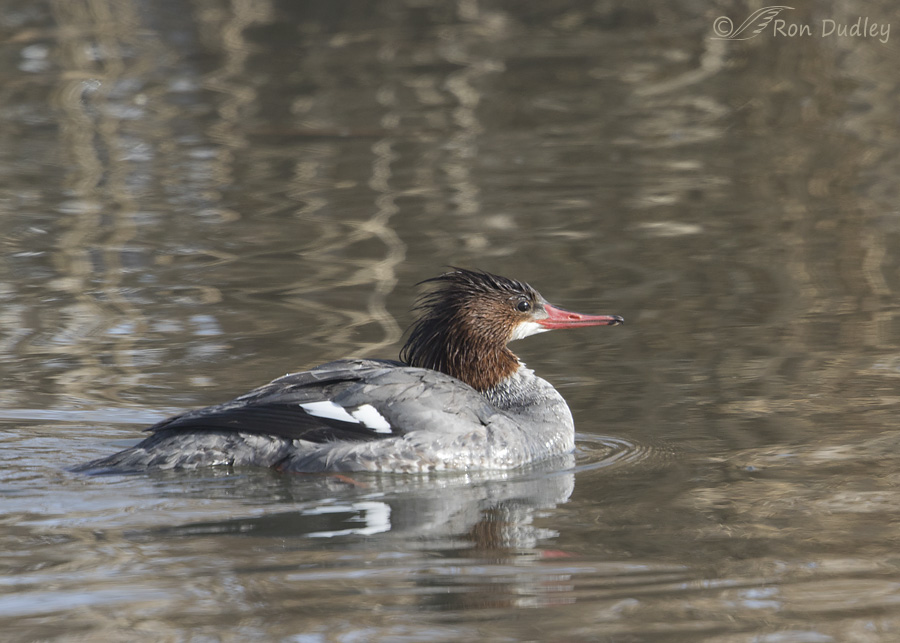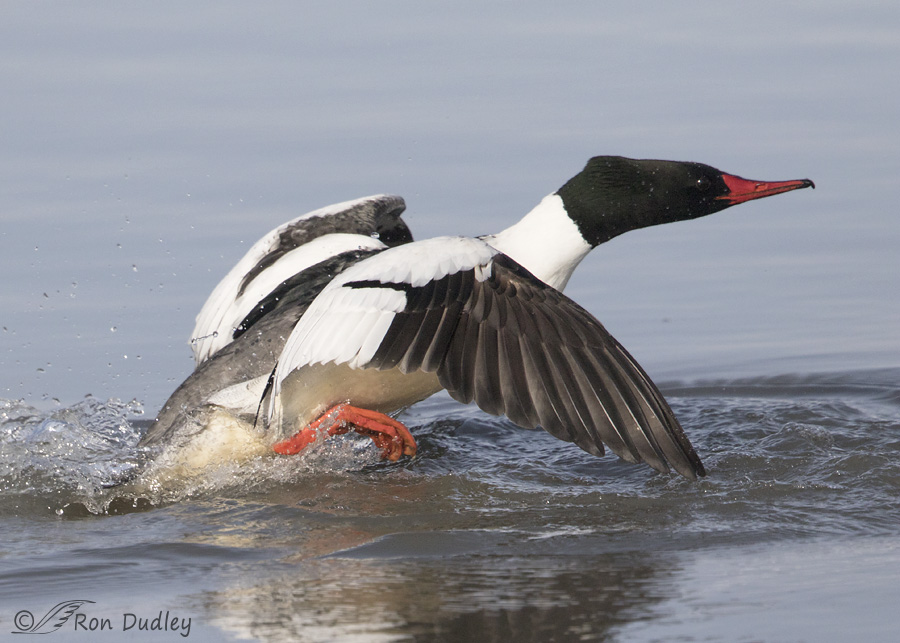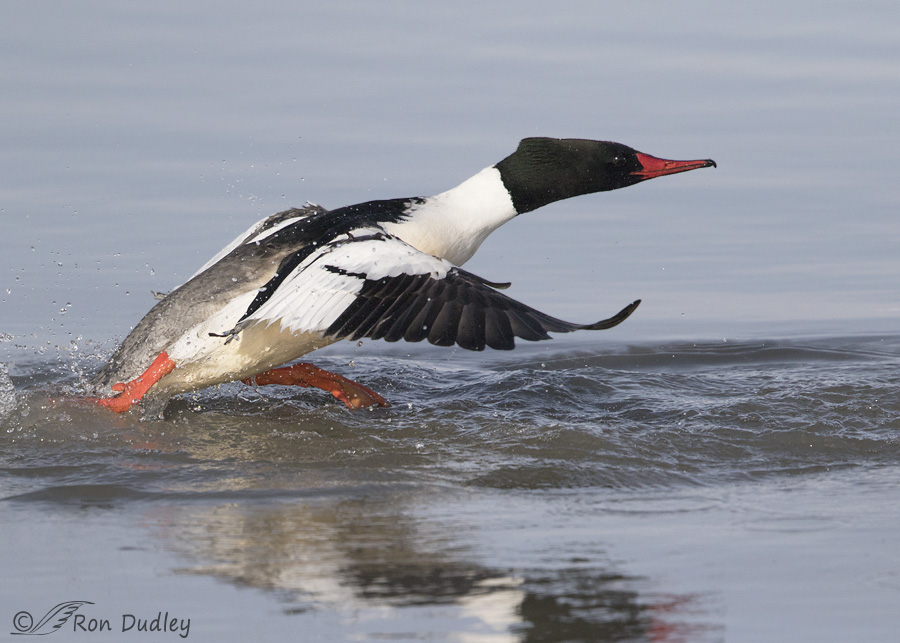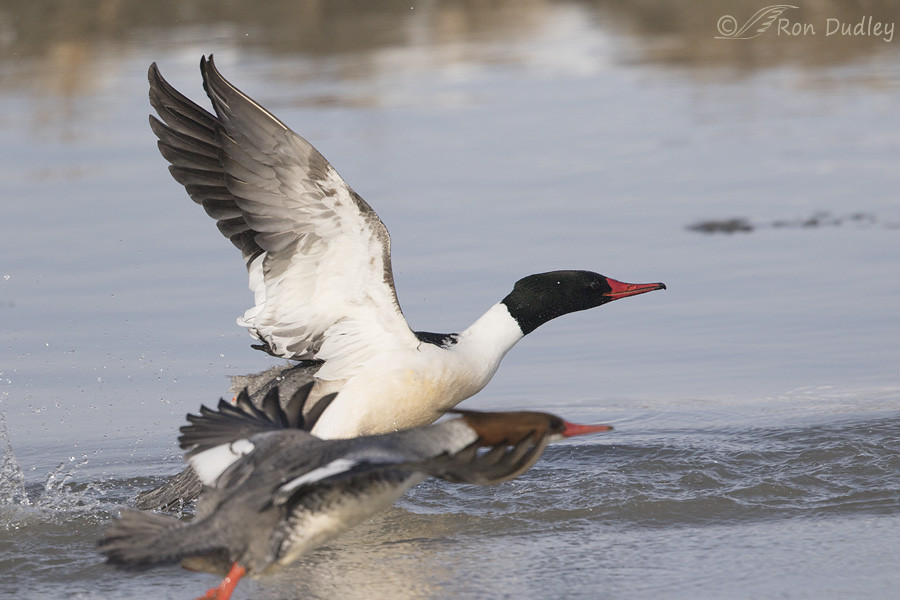I have no idea how I was able to get this bird in frame in time, much less lock focus on it.
I include the first shot below for no other reason than to help me tell the story.
1/800, f/9, ISO 320, Canon 7D Mark II, Canon EF 500mm f/4L IS II USM + EF 1.4 III Extender, not baited, set up or called in
While shooting from my pickup window yesterday morning I had this far-away female Common Merganser in my viewfinder when I noticed that my shutter speed was much slower than I prefer (because the water was so dark) for birds who may become active so I decided to increase my ISO to 500 and change my aperture to f/6.3 to rectify the situation. But in the split second after I’d increased my ISO (and before I could adjust aperture) I heard a commotion to my left and behind me at a very awkward and almost impossible angle out my window.
I knew what it was before I even saw its source – several Common Mergansers (that I knew were there) had started running across the water to the other side of the pond. I don’t know what made me even try for the shot – my settings were all wrong for the situation, I was probably too close to the birds to avoid clipping body parts and besides it would be a miracle if I could swing my long and cumbersome 500mm lens back 90° in time to get an already running bird in frame and in focus. And by this time the birds were moving at blazing speeds so this was definitely one of those “poke and hope” situations.
But instinct and reflexes took over and without even thinking about it I made the effort. I had no idea what I got until I arrived home but I was far from optimistic. Typically when I think I might have taken an interesting shot or two I’ll preview them in the field on my screen but for these photos I didn’t even bother.
1/8000, f/9, ISO 500, Canon 7D Mark II, Canon EF 500mm f/4L IS II USM + EF 1.4 III Extender, not baited, set up or called in
This was the first image in the burst. I was blown away that I didn’t clip any body parts, the merganser was sharp and I liked the posture of the bird. True, I don’t have enough room on the right for a composition that pleases me but hell, given the situation how much more could I ask for?
1/8000, f/9, ISO 500, Canon 7D Mark II, Canon EF 500mm f/4L IS II USM + EF 1.4 III Extender, not baited, set up or called in
This is the next photo in the burst and for this one I do have a little more room on the right. I got more images after this one but there’s actually a running female merganser just out of frame to the left and she was even faster than he was so she ruined those shots as she passed between us.
I keep thinking of all the ways I was lucky to get these shots, including:
- getting the bird in frame and sharp in the first place, given how little time I had and the awkward angle I was dealing with
- getting the exposure correct (or close enough) with the dramatically different brightness of this setting as compared to the previous one (which accounts for my ridiculously high shutter speed)
- I was so close to this bird that my typical aperture setting wouldn’t have given me enough depth of field to get the entire bird sharp. But the f/9 my camera was already set at worked perfectly
If I’d had an opportunity to think about it I wouldn’t have even tried for these shots because the chances of success were just too remote. One of my bird photography mantras when I’m trying to decide where/if to go shooting when I might (or might not) find birds is “you never know unless you go”.
Well, in a variation of that theme, “You never know unless you try”. Pixels are cheap and sometimes we get lucky!
Ron
PS – This post may be a little “photo-geeky” for some and for that I apologize. But I suspect that readers who are bird photographers who regularly shoot with long lenses will understand my amazement at getting these images. And perhaps it will inspire some of them to make the effort in near-impossible situations. Occasionally it pays off…
Addendum: As a very late afterthought I thought some viewers might be interested in seeing one of the images where the female has caught up with and is passing the male. She was one speedy lady! The image is full frame (uncropped).






Unbelievable awesome shots Ron! Congrats!
Charlotte
GORGEOUS! Oh goodness =)
Late to the party, Ron, but what a wonderful series! Don’t know which one I like better- yesterday’s Scaup or today’s Merganser! Simply amazing!
Enjoy them both, Diane. Thanks.
I love the picture of the female passing the male!That’s the best action shot that I haven’t seen before! good merganser pics, yes. Female racing mergansers , no. Awesome!
Thank you, Beth.
You got the run, nailed it…. feel proud.
I do, Ron. Both proud and lucky…
Lucky you, they came our wonderful. I especially love the first shot.
Thanks, Jean.
Oh and there’s another one: “Luck is the residue of design.” Don’t know the attribution of that one.
I looked it up, Laura. Most sources attribute it to Branch Rickey, the guy who signed up Jackie Robinson for major league baseball.
HA! Then Roger Penske pilfered it shamelessly. NOT a surprise…LOL!!
I looked up the Penske quote below and apparently it originally came from the Roman philosopher Seneca.
The quote, from Roger Penske (I’m roughly 99.873% certain of that) is, “Luck is where preparation meets opportunity.” I’d also add and the guts to try! And that would be you all over! OUTSTANDING!!! Just OUTSTANDING!
Thank you, Laura.
Great captures Ron. There is luck, then there is talent. Both definitely come into play here. Where the real luck is here is the sun angle. I’d like to speculate. In the first image, considering the shadow on the back of the neck of the female, the sun was behind you, but on your right side, maybe 45 degrees or more. As you heard the male start to run, he was on your left and as you rotated (you say 90 degrees) left, the sun became more directly behind your view angle. With that angle, the whites on the bird became brighter, three stops brighter, and the camera adjusted accordingly. Am I even close?
As I have said in the past, I shoot mainly manual metering. When you are at the same view angle, +/- 10 to 15 degrees, the light is going to be pretty much the same so your camera settings will hold up when you rotate within that range. But when you make dramatic shifts in your angle of view, like you did, the light angle on the subject changes and an exposure compensation is necessary, which your 7DII did. So, my speculation is you never would have gotten this shot with the right exposure had you been in manual. I have been trying to get a better understand of what conditions one would want to use an auto exposure mode, as compared to manual,l and you just gave me a prime example and broadened my horizon a bit on taking more advantage of the features these cameras have to offer.
Good photography lesson here Ron, and I appreciate it.
“Am I even close”
Yup, you’re pretty much dead-on about both light angles, Frank.
The RAW files in those last three shots were moderately underexposed but I brought them up in ACR.
Thats because your such an awesome photographer Ron! You naturally get amazing shots! Even though I’m a very rough novice in photography, I think I can still say this. Your photos just blow me away.
I am lucky to have your genes! If I am ever able to financially start head-on into videography again, I’m sure deep down in me somewhere, I will use those genes. If I’m lucky I will be able to reap at least a small percentage of your talent, in my field of preference.
Thanks again for sharing your work! It is a joy to see and and inspiration myself and to MANY others I’m sure.
Take care uncle and be safe out there in the wild.
How nice to hear from you on my blog, David, and thanks for the kind words. I sure hope you’re doing well!
I enjoy the photo geekiness and the photos. Maybe you will see them in breeding season in your travels to Idaho or Montana.
Last time I was out shooting there were not many open water holes and the ones that were open were very crowded. It was hard to get a decent photo between the poor light and photo bombing of other birds. I had some beautiful shots ruined by gulls flying in to steel the catch of the subject I was filming.
April, I do see them in Montana during breeding season but so far I’ve never even seen a chick. And they’re very hard to get close to up there in those wild places.
They are spooky anywhere! Open the front door and if they are down on the creek they are gone! 🙂
I especially like the second action shot, because you can tell that the bird is running across the water. I know from previous posts about Grebes that birds do this, but these shots show the action in a way I’ve not seen before. In the last shot with the speedy female, it looks like she may already be in the process of takeoff. I’m really glad that your instincts paid off and that you took a chance to get these shots. I have concluded that at times like this, still photos are better than video, because they bring home the action in a way that one can stop to really ponder it.
I agree with you about photos vs video, Susan, for the reason you mention and others. They each have their pluses and minuses but given the choice I usually prefer still images. I always have a video cam with a strong telephoto lens with me but I seldom use it because I must choose one or the other – don’t have enough hands and eyes to use both at the same time.
This, “You never know unless you try.” Gorgeous, exciting photos, and your telling of your surprise at the pleasing outcome is delightful!
Every once in a while good stuff happens, Susan – that helps to keep me going!
I photograph feathered friends more than any other animal CUZ there are more! I often react to swift movements and like you said – pixels are cheap! I’ve been very lucky too! I really enjoyed your tech info also. Shooting on Manual forces my settings readjustment whenever I enter a new light/darkness while hiking. Thanks for this post! Linda
Thanks very much, Linda.
On revisiting: Love the action shots, but also love the first of the serene lovely lady…like how the antiqued copper colors in the lady’s “hairdo” are reflected in the colors of the water. Lately, I’ve become especially aware( and appreciative!) of the water in both your and Mia’s images…often almost viscous- looking, sometimes looking like silk, always beautiful—and both complementary and complimentary to your subjects…nice!!!
Agreed, Patty. Sometimes the water colors, patterns and reflections can be almost as important to the image as the bird itself.
Fantastic! The better you are the “luckier” you get. It also shows that part of the fun is letting your reflexes take over. Wonderful shots and great story.
“It also shows that part of the fun is letting your reflexes take over”
Yup, it sure can be, Jeremy. But a healthy dose of frustration is usually a big part of the mix. Thank you.
I was admiring the beautiful shot of the female…(love both bird and water–colors and patterns), then scrolled down to the other two shots–incredible!!! The athleticism shown in these two shots is amazing!…that you were able to catch them is equally amazing!!! The way they use both wings and feet to rocket aross the top of the water, makes me wonder if they also use those paddle feet as well as their wings to push themselves up into the air for takeoff…(obviously, I’m a slow learner!)….the implication of speed, makes the fact that these images are so crisp, clear and sharply detailed, instead of one big blur, seem miraculous!!!
“makes me wonder if they also use those paddle feet as well as their wings to push themselves up into the air for takeoff”
Patty, when this species takes off from the water they use both their wings and their running feet to gain speed and then very slowly increase their elevation from the water rather than taking off at a steep angle. I don’t know it for fact but I suspect it’s because they have a heavier wing load than many other waterfowl.
This male never did take off – he just ran across the water until he reached his destination and then settled back down again. The female that I mentioned was right behind him actually did leave the water.
Thank you. 🙂
Mornin’, Ron–I forget who said it, but I have always liked the description of luck as, “A collision between preparation and opportunity”. Nice collision!…Best…Mitch
“Nice collision!”
That made me smile, Mitch. Thanks.
‘Tain’t luck, Ron. That’s some mad skillz, that is! Very, very cool!
Most likely some of both, Marty – but very heavy on the former. Thank you.
Most intriguing images I’ve seen in a whlle, Ron. Bit of luck, a lot of practice and great skills combined to give these results. Or did you find a “magic” camera😊?
Bill
Ha, my camera is usually far from magic, Bill – though in this particular situation maybe a little temporary pixie dust from the photography gods saved the day!
Sweet. Certainly not just luck. A skilled bird photographer with many hours in the field prepared you for this opportunity. Nicely done.
Thanks, Keith. Coming from you that means a lot.
WOW, Ron…these are fabulous! Congratulations!
I’m glad you like them, Sharon. Thank you.
Great shots Ron. I believe in luck, but sometimes you make your own luck…nothing ventured nothing gained! Way to go.
Thanks, Jerry. In these situations I always think of a quote from (I believe) pro golfer Gary Player – “The more I practice the luckier I get”.
You must have thought, “Miracle by God I did it!!!! Yeah!
I can visualize you in front of your computer after the initial recognition with a broad proud grin!
Man, those are terrific shots – Congratulations!!!
Yeah, that was a fun surprise when I finally saw the images, Dick. I sure didn’t expect it!
Sometimes I think of the line from Forest Gump and modify it: Photography is like a box of chocolates, you never know what you’re going to get!
What a JOY to get really spontaneous shots like these, “not baited, set up or called in.” Love, love, love them!!!
I like your Forest Gump quote modification, Pat – a perfect variation for bird photography. Thank you.
Run, Forrest!!!
Beautiful! They are quite impressive when they start running on the water. 🙂 I love the females running on water with umpteen babies on their back or a whole flock of current years young doing it all at once. Called good reflexes from MANY years of practice and a bit of luck. 🙂 That having to stop and change a setting can get you every time…………..:)
Judy, I’d love a chance at youngsters of this species but as far as I know they don’t breed here. Thank you.
I’ll just say WOW. The image of the male running is wonderful and I really appreciate your ‘geeky’ comments.
Good, Hila. I’m glad the geekiness wasn’t too much for you. Thanks.